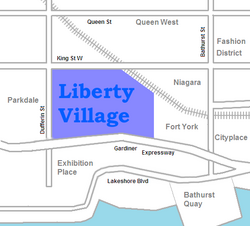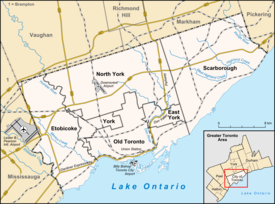Liberty Village
| Liberty Village, Toronto | |
|---|---|
| Neighbourhood | |

A view of Liberty Village, looking west from Hanna Avenue, down Snooker Street towards Atlantic Avenue.
|
|
 Vicinity of Liberty Village |
|
| Location within Toronto | |
| Coordinates: 43°38′13″N 79°25′19″W / 43.637°N 79.422°WCoordinates: 43°38′13″N 79°25′19″W / 43.637°N 79.422°W | |
| Country |
|
| Province |
|
| City |
|
Liberty Village is a neighbourhood in Toronto, Ontario, Canada. It is bordered to the north by King Street West, to the west by Dufferin Street, to the south by the Gardiner Expressway, to the east by Strachan Avenue, and to the northeast by the CP railway tracks.
Liberty Village is located on one of Toronto's oldest settlements.
Fort York, on the south edge of community, was established by the British military in 1793.
In the 1850s, both the Toronto, Grey and Bruce Railway and the Great Western Railway laid tracks across the community, cutting it off from rest of the city and altering plans to develop the area for residential purposes. Instead, Liberty Village became home to several institutions, including the Toronto Central Prison, opened in 1873, and the Andrew Mercer Reformatory for Women (on the site of today’s Lamport Stadium), opened in 1878 for women convicted of "vagrancy", "incorrigibility", or "sexual precociousness." Provincial Secretary William John Hanna forced the closure of Central Prison in 1915, and all its buildings were demolished except for the paint shop and chapel. "Liberty Street", for which Liberty Village is named, was the first street both male and female convicts would walk once freed.
The area's proximity to the railway tracks led to its growth as an industrial area. In 1884, John Inglis and Company opened a factory to manufacture heavy machinery, boilers, and later, electrical appliances. Inglis' success led to its expansion onto Central Prison lands. In 1891, Massey-Harris (later Massey Ferguson) built a factory to produce agricultural implements. Other companies which established in the late 19th century included Toronto Carpet Manufacturing, St. David’s Wine, and Ontario Wind Engine and Pump.
...
Wikipedia

